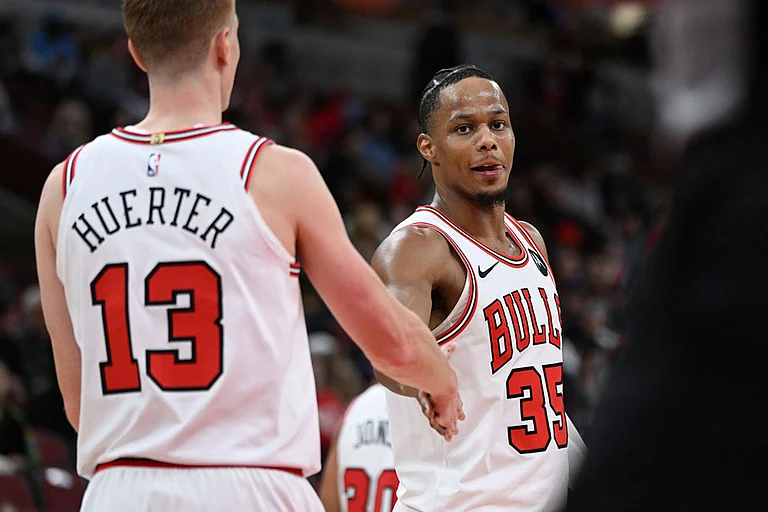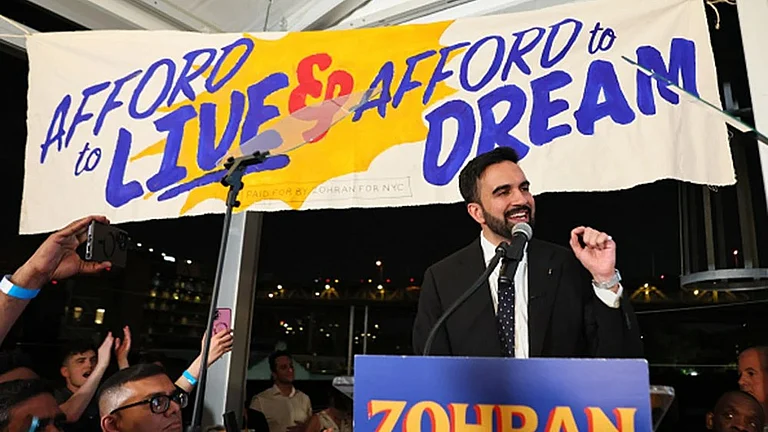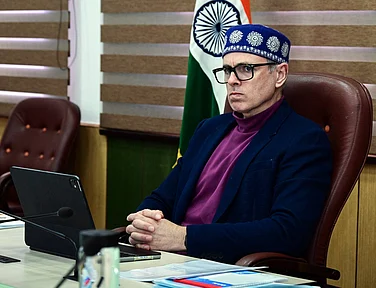In 2003, India’s Northeast witnessed an unprecedented political churning when the then chief minister of Arunachal Pradesh, Gegong Apang, merged his Arunachal Congress party with the BJP. Overnight, the BJP found itself in power in the hill state, a first for the saffron party in a region which was then an impregnable fortress of the Congress. A few months later, Apang returned to the Congress and normalcy was restored. Nearly two decades later, the Congress has been wiped out from the region. The BJP is the new lord and master—in power in all seven states, either on its own or in coalition. But politics, like the weather, continues to remain as fickle as it was ever before in the Northeast.
And it’s not without reason that Bihar chief minister Nitish Kumar’s Janata Dal (United) is seeking a piece of the power pie in Manipur which is voting to elect a new assembly. Despite the fact that the party has very little presence in the state, the JD-U has fielded candidates in 39 out of the 60 seats, roping in at least 15 sitting MLAs and other prominent leaders who jumped ship after they were denied tickets by the ruling BJP and the challenger Congress. It’s another matter that the JD-U is a partner in the BJP-led National Democratic Alliance (NDA) at the Centre. For the record, it’s not the first time the JD-U is contesting polls in Manipur. Rajkumar Doren Singh, the party’s state general secretary, is a confident man. “We are confident of forming the next government alone.”
History, if not anything else, seems to favour the underdog in Manipur. In 2017, the BJP had managed to snatch power from right under the nose of the Congress, which had emerged as the single-largest party with 28 seats, seven more than BJP’s 21. But the BJP made the first moves to successfully woo the four MLAs each from the National People’s Party (NPP) and the Naga People’s Front (NPF), one from the Lok Janshakti Party and an independent candidate. N. Biren Singh, a Congress turncoat, was installed at the helm of the first saffron government in the state. It also marked the end of a 15-year-long reign of the Congress.

Present tense
The Congress is facing an existential crisis in the state, as in most other places. The BJP too is not faring much better, faced with anti-incumbency and internal strife. It’s precisely for this reason that political experts are predicting a repeat of 2017 and smaller parties playing the kingmaker once again. And that gives the BJP a better shot at power than anyone else, though social scientist and political expert Dhanbir Laishram is not too sure about the efficacy of such groupings. “While a coalition government in a multi-party system is absolutely fine, the problem is not having common interests among these coalition or alliance partners,” Laishram tells Outlook. “The tendency is to follow the ruling party at the Centre and be in a position of power despite not having common goals and interests.”
While smaller parties are comfortable with this power-sharing arrangement, the BJP has set its sights on taking out this very equation from the picture—this time the party is contesting alone and hoping to form the government on its own. To stop the BJP, the Congress has gone for its tried and tested pre-poll alliance with Left parties. The Progressive Secular Alliance of Congress includes the CPI, CPM, Forward Block, RSP, and Janata Dal (Secular), a formation going back to 1972.
Among the smaller parties, the Naga People’s Front (NPF) and the National People’s Party (NPP) led by Meghalaya chief minister Conrad Sangma are hopeful of playing bigger roles in government formation than five years ago. In particular, the NPP is looking at bigger dividends by fielding 41 candidates. The NPP has also given hints at moving away from the BJP after accusing the ruling party of engaging militants for campaigning. The NPP and BJP are also partners in Meghalaya’s coalition government. The NPF, which is another BJP ally, has not entered into a pre-poll alliance though party leader Achumbemo Kikon has indicated the possibility of the NPF and BJP coming together once again in case of a hung assembly. “There’s no open alliance as such with any other political party but our understanding with the BJP continues because our members are still part of the government. We cannot fight head-on; we have to go on a certain level of understanding. That understanding remains as we are a part of the same government,” Kikon had said earlier.
For the BJP, the smaller parties like NPF are vital to its plans in the Northeast, a politically volatile region where small communities are slowly asserting themselves and seeking more power for themselves. It was through alliances with such parties—part of the BJP-led North East Democratic Alliance (NEDA)—that the BJP has managed to uproot its main rival Congress from the entire region.

Past imperfect
The year 2022 marks the 50th year of Manipur becoming a full-fledged state of the Indian Union. However, the state’s fractured past has always cast its long shadow on the present. And spawned several armed rebellions by different tribes and communities that continue to convulse the state from time to time.
ALSO READ: Federalism And The Idea Of Regionalism
An independent kingdom since the first century AD, Manipur was annexed into British India in 1891 after a brief war—the Battle of Khonjam. It is a price that Manipur had to pay for taking help of the British to liberate the kingdom from Burmese occupation in 1826. Manipur remained a princely state till 1947. On October 15 1949, Manipur merged with India as a Chief Commissioner’s Province. From the time Manipur was integrated into the Indian Union and it attained statehood in 1972 to the current decade, the political history of Manipur is one of factionalism and fractured mandates.
The hills and the valley of Manipur are dominated by three major ethnic groups—the Meiteis, Nagas and Kukis. The majority Meitei community, which comprises at least 53 per cent of the total population, dominates Imphal valley as well as the power corridors. A large section of the Meitei community believes that their right to self-determination was violated by the Indian government when it forced the then king, Maharaja Bodhchandra Singh to sign the Merger Agreement without any discussion and ratification of the newly-formed legislature of Manipur. Relations between the Centre and the state have remained tense ever since.
Between 1948 and 1972, the Congress played a significant role in the political scenario though it was riddled with factionalism and defections. The involvement of the Centre in the administration of the state, as well as the political instability between 1972 and 2001 can be witnessed in terms of Manipur’s change of guard on 18 occasions with as many as eight chief ministers taking guard. President’s rule in Manipur accounted for three additional assembly elections.
Manipur was three years ahead of the Indian State in conducting elections. The first election in India was held in 1952 but Manipur conducted the polls in 1948. In that election, contested by the Congress, the Communist Party of India and the Socialist Party, none emerged as the single-largest party and a coalition government was formed by the Manipur Praja Shanti Seva, a loose grouping of pro-royalists, with an assembly of 53 members.
Fast forward to 2022. As Manipur votes to elect a new government, outgoing CM Biren Singh is hopeful that he would not need any grouping to head the state once more. “The question of a hung House will not arise. I am not saying it without any basis. I am calculative. There are 60 seats and we have fielded 29 sitting MLAs. Their winnability is very high. It will be very easy for the BJP to add another 11 to the tally to achieve a two-thirds majority,” he said. But stranger things have happened in politics. And the Northeast is no stranger to the bizarre.
(This appeared in the print edition as "Grand Theatre")
ALSO READ
Syeda Ambia Zahan in Guwahati


























